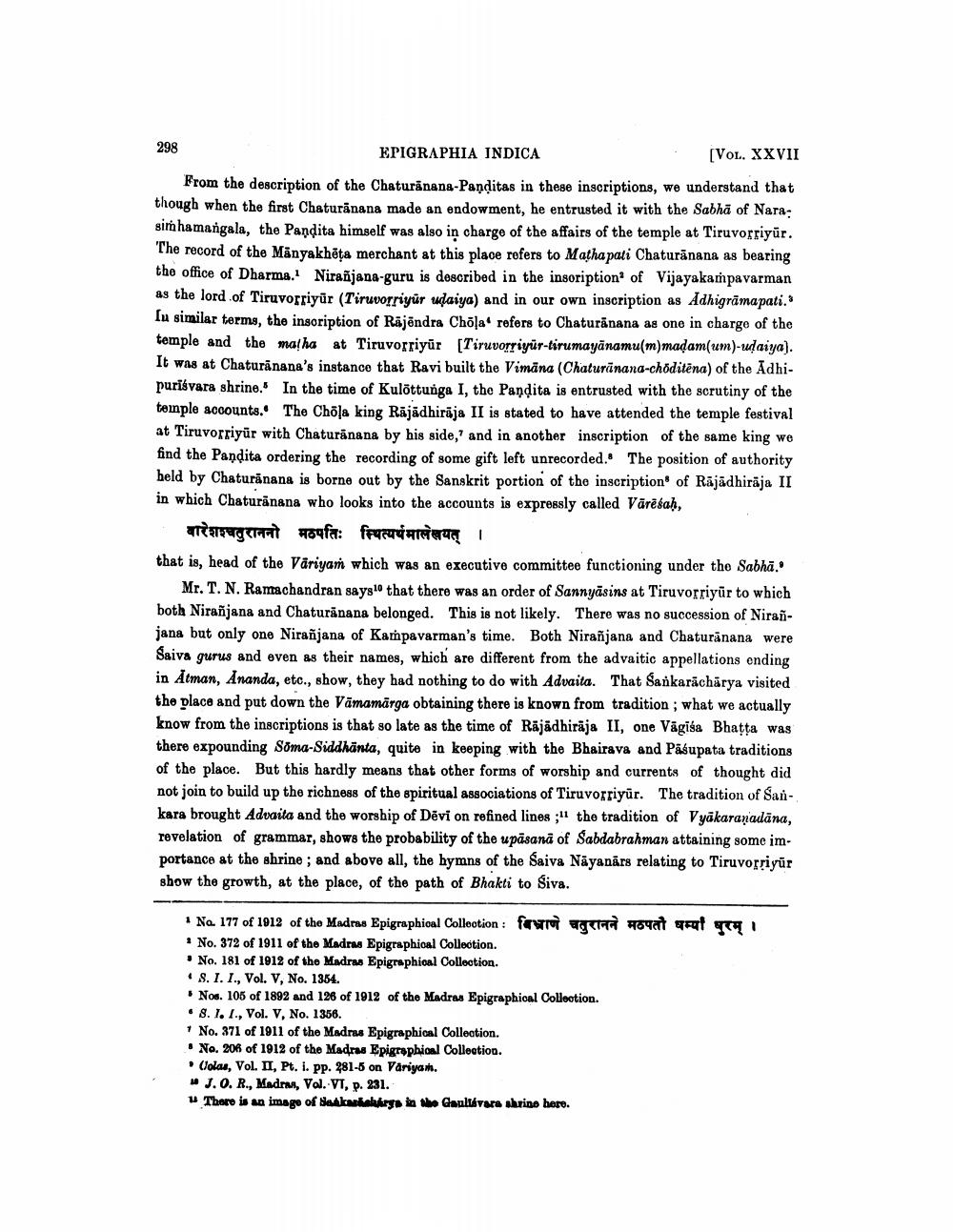________________
298
EPIGRAPHIA INDICA
[VOL. XXVII
From the description of the Chaturanana-Panditas in these inscriptions, we understand that though when the first Chaturanana made an endowment, he entrusted it with the Sabha of Narasimhamangala, the Pandita himself was also in charge of the affairs of the temple at Tiruvorriyür. The record of the Manyakheta merchant at this place refers to Mathapati Chaturanana as bearing the office of Dharma. Niranjana-guru is described in the insoription of Vijayakaṁpavarman as the lord of Tiruvotriyur (Tiruvorriyur udaiya) and in our own inscription as Adhigramapati. In similar terms, the inscription of Rajendra Chōla' refers to Chaturanana as one in charge of the temple and the matha at Tiruvorriyür [Tiruvorriyür-tirumayanamu(m)maḍam(um)-uḍaiya). It was at Chaturanana's instance that Ravi built the Vimana (Chaturanana-chöditena) of the Adhipuriśvara shrine. In the time of Kulottunga I, the Pandita is entrusted with the scrutiny of the temple accounts. The Chōla king Rajadhiraja II is stated to have attended the temple festival at Tiruvorriyur with Chaturanana by his side,' and in another inscription of the same king we find the Pandita ordering the recording of some gift left unrecorded. The position of authority held by Chaturanana is borne out by the Sanskrit portion of the inscription of Rajadhiraja II in which Chaturänana who looks into the accounts is expressly called Vārēśaḥ,
वारेशचतुराननो महपतिः स्थित्यर्थमालेखयत् ।
that is, head of the Väriyam which was an executive committee functioning under the Sabha.
Mr. T. N. Ramachandran says 10 that there was an order of Sannyasins at Tiruvorriyur to which both Niranjana and Chaturanana belonged. This is not likely. There was no succession of Nirañjana but only one Niranjana of Kampavarman's time. Both Niranjana and Chaturanana were Saiva gurus and even as their names, which are different from the advaitic appellations ending in Atman, Ananda, etc., show, they had nothing to do with Advaita. That Sankaracharya visited the place and put down the Vämamarga obtaining there is known from tradition; what we actually know from the inscriptions is that so late as the time of Räjädhiraja II, one Vagisa Bhaṭṭa was there expounding Soma-Siddhanta, quite in keeping with the Bhairava and Pasupata traditions of the place. But this hardly means that other forms of worship and currents of thought did not join to build up the richness of the spiritual associations of Tiruvorriyür. The tradition of Sankara brought Advaita and the worship of Devi on refined lines; the tradition of Vyakaranadāna, revelation of grammar, shows the probability of the upasana of Sabdabrahman attaining some importance at the shrine; and above all, the hymns of the Saiva Nayanars relating to Tiruvorṛiyür show the growth, at the place, of the path of Bhakti to Siva.
1 No. 177 of 1912 of the Madras Epigraphical Collection: farragend mount amat ge
No. 372 of 1911 of the Madras Epigraphical Collection.
No. 181 of 1912 of the Madras Epigraphical Collection.
S. I. I., Vol. V, No. 1354.
* Nos. 105 of 1892 and 126 of 1912 of the Madras Epigraphical Collection.
8. I. I., Vol. V, No. 1356.
No. 371 of 1911 of the Madras Epigraphical Collection.
No. 206 of 1912 of the Madras Epigraphical Collection.
(Jolas, Vol. II, Pt. i. pp. 281-5 on Väriyam.
J. O. R., Madras, Vol. VT, p. 231.
There is an image of Saakaráskárys in the Gaultivara shrine here.




